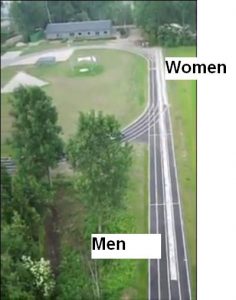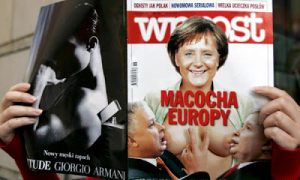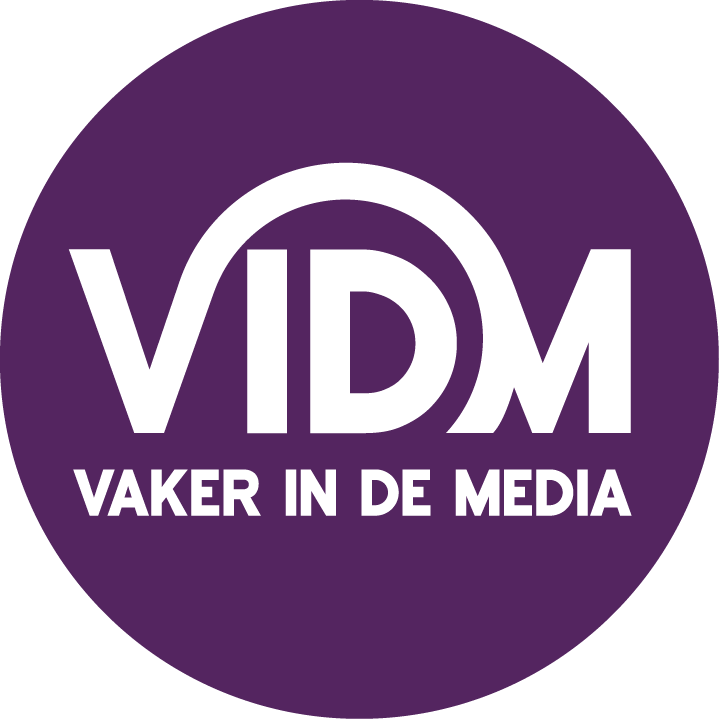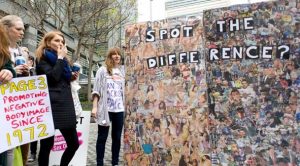You can’t be what you can’t see!
an intriguing investigation about the visibility
of women in European media
6/7/2013, The Netherlands. The protest against Page 3 in England made it clear that women in the media are portrayed differently than men. That triggered me to see research pictures of men and women in European newspapers. Many newsrooms start their day with sifting through the papers. If women already are invisible as experts, inevitably that will be the case in all other media.
138 meters of footage
For a period of four months we cut out all pictures of men and women from 136 randomly selected editions of newspapers (87 titles, 22 countries). Afther the cutting we posted the pictures on long sheets. Men and women separated. It collects 138 meters of footage! Also containing the paper ads. If you quickly browse a newspaper, it all seems so bad to coincide with the imaging. Until you just pull out the pictures and paste them consecutively. Although I see al lot of things by my focus on the subject, I was stunned to see the huge difference in portraying men and women.
Some salient facts:
• Only 16 percent of photos in European newspapers are ‘women over 45 years of age’.
• 78 percent of photos of women in European newspapers show women under the age of 45.
• Women are represented in only 5 percent of photos within the sports sections of European newspapers.
• Only 30 percent of photos in European newspapers depict women (advertisements are included)
• Women in the media mainly fulfill the role of wife, mother, actress or model.
 We used an athletics track to take a good look at the newspaper pictures. Clearly the large difference in volume of this inequality has long been present and improves very slow. Slower than the increase of women in the labor market. In terms of numbers of women in the media the Netherlands scores average. We even have the most educated women in Europe… Unfortunately, we do not see that reflected in the presence of female experts in the media.
We used an athletics track to take a good look at the newspaper pictures. Clearly the large difference in volume of this inequality has long been present and improves very slow. Slower than the increase of women in the labor market. In terms of numbers of women in the media the Netherlands scores average. We even have the most educated women in Europe… Unfortunately, we do not see that reflected in the presence of female experts in the media.
Inequality confirmed
Back to Europe. With only 12 percent of all news stories a woman is the central subject. Women are underrepresented in the media. This suggests that the standard is men and women have no share in our society. Men and women are portrayed stereotype by the media. This ensures that the inequality between men and women is confirmed and the unequal treatment stimulated. Stereotypical portrayal of men and women means that women make different choices in studies for example. This result in the fact that for women it’s hard to move up to higher positions in the labor market. By stereotypical portrayal of women in the media the full use of their potential is limited.
Women are especially mother
 The media creates us a picture of the reality that we (should) believe. How do you find it’s strange women make stereotype affirming choices when they get presented that women especially are mothers from an early age. And presented as wifes. And that women only get the attention as long as they are attractive enough. Of all the presenters in the age 50 to 64 only 7 percent is female.
The media creates us a picture of the reality that we (should) believe. How do you find it’s strange women make stereotype affirming choices when they get presented that women especially are mothers from an early age. And presented as wifes. And that women only get the attention as long as they are attractive enough. Of all the presenters in the age 50 to 64 only 7 percent is female.
Nora Van Oostrom, spokesman of the board of the Royal Notarial Association, talks about it in the video ‘You can not be what you can not see’ how it feels to be interviewed by the media being a women. Questions are almost everytime about how she combines her work life with family life. In the case of women the media connects family status three times as often than they do with men. Her appearance (blond, slim) always counts on comments from interviewers. Joining talk shows feels like joining a men’s club where men are stunned when they realise she is not only beautiful, she has something to say also, according to Van Oostrom.
Female athletes vs. male athletes In sports we detect the same trend: women are hardly taken seriously. Of all the sports people we found in 136 newspapers, only 5 percent were pictures of women. We are used to not seeing women’s sports we hardly wonder about the fact. At this rate after all, we enjoy watching a soccer game and those are men ofcourse? No, there are female soccer players also. And if you say that it’s not attractive (because I really heard those comments) then you have to wonder how women judge themselves. Men’s sports got a lot of attention so the audience could build a bond with the sports and the athletes in the media. Why is the attention different for female athletes? If they remain invisible, potential sponsors will not be interested. I think in any profession, the gap between men and women in financial reward is greater than in sports. Men and women seen in a similar way, not stereotype, creates equal financial opportunities. As long as the white middle-aged man deciding how it will be and who will be visible to the general public, the economic backwardness of women remains in position. 46 Percent of the news coverage in European stereotype is invigorating. Only 4 percent is against stereotypical portrayal. The EU wants more women progress to senior positions. It has been shown that with the versatility of men and women best results results are achieved. Economy needs women to recover. Research shows that men are more likely stereotyping than women. If the high positions in the media remain occupied by men, there will also be a lack of female role models in the media.
Austria: quotas for female features
Media are intertwined with our daily lives. They have a strong influence on how we see reality. What we thinks is realistic. Media create a frame from which we view our society. This frame is created from the perspective of the white middle-aged man. Because they own positions where decisions are made, where media content is made that we consume daily. In strategic places in media organizations only 16 percent are women.
In Austria, the government has set quotas for public broadcasting. In 2018 at least 45 percent of the women will be occupying positions in each department. Also on the technical department, the cameramen. If there’s a position and no women had applied for the job, the application process will be prolonged, thereby allowing more time to find women as applicants. The long discussion about why there are not more women in those positions is gone. The focus is on how they will achieve this. A good thing, because it speeds up the battle for equality. A women’s voice is missing within the creators of and responsible for media content. Who turns the image of the world in the media? As Anya Wiersma (Member of the Supervisory Knowledge Institute for Gender Equality and Women’s History ATRIA) said: “Diversity is a word that doesn’t exist in the media.” It is important that men and women have equal access to express their knowledge and opinion in the media. There should be a wide variety of female role models visible. We need to help the next generation of women washing away the idea that nurturing and appearance is one of the best abilities they have.
Do we take up this challenge?
Let’s start today showing women are at least as competent and versatile. May we have as much to offer and as much ambitions. May other women who came before you fully exploit their potential. Let’s take our responsibility with the media. Make the media more accessible to women and reject stereotyped portrayal. And women you have to take the opportunity to show yourselves in your fields of expertise, with your knowledge, your profession! Because, you can not be what you can not see…
Twitter: #UcanBwhatUcantC

